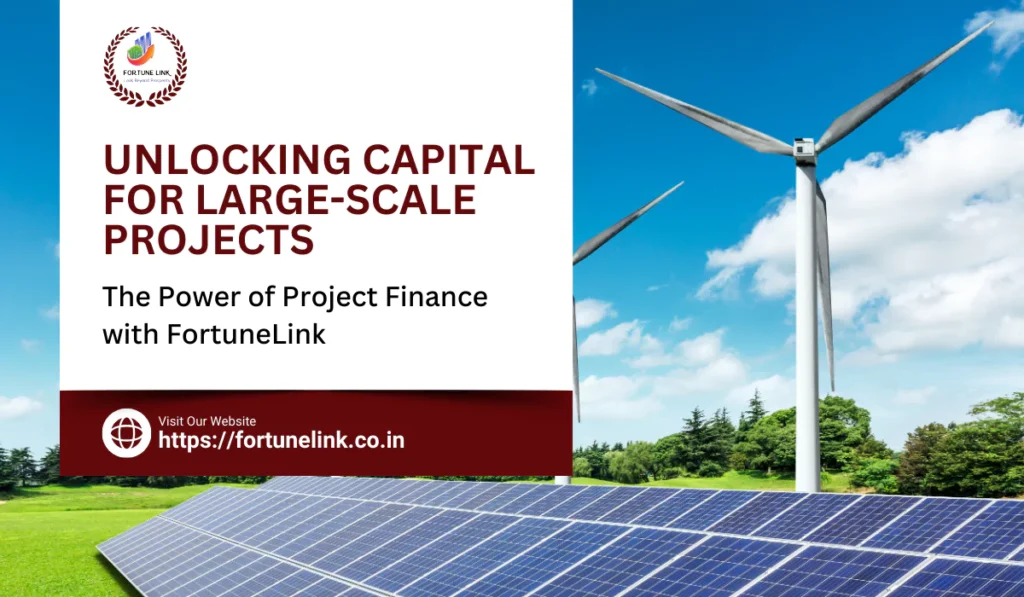
Unlocking Capital for Large-Scale Projects – The Power of Project Finance
In the world of large-scale projects, whether it’s infrastructure development, renewable energy initiatives, or industrial ventures, one of the most critical elements for success is securing adequate financing.
Project finance has emerged as a powerful tool to unlock the capital needed for these ambitious undertakings. By leveraging a project’s future cash flows and assets as collateral, project finance allows businesses to raise substantial funds while minimizing their exposure to financial risk.
This article explores the intricacies of project finance, its benefits, and how it can be effectively utilized to unlock capital for large-scale projects.
Understanding Project Finance
Project finance is a specialized form of financing used primarily for long-term infrastructure and industrial projects. Unlike traditional corporate finance, where a company’s balance sheet and creditworthiness are the primary considerations, project finance focuses on the project’s ability to generate cash flows.
This approach isolates the project’s financial risk from the parent company, making it a highly attractive option for both sponsors and lenders.
Key Characteristics of Project Finance
- Non-Recourse or Limited Recourse: In project finance, lenders have limited or no claim on the parent company’s assets. Instead, they rely on the project’s cash flows and assets as collateral. This means that if the project fails, the lenders can only claim the project’s assets, not the parent company’s.
- Special Purpose Vehicle (SPV): A separate legal entity, known as an SPV, is created to own and operate the project. This structure helps isolate the project’s financial risk from the parent company and facilitates the management of contracts, financing, and operations.
- Risk Allocation: Risks associated with the project are allocated among various stakeholders, including sponsors, lenders, contractors, and off-takers, through carefully negotiated contracts. This risk-sharing mechanism is fundamental to the success of project finance.
- Long-Term Contracts: Projects typically have long-term contracts with suppliers, customers, and other stakeholders to ensure stable cash flows. These contracts provide the predictability needed to secure financing.
Benefits of Project Finance
Project finance offers several advantages that make it an ideal choice for funding large-scale projects –
- Risk Mitigation: By isolating the project’s financial risk from the parent company, project finance protects the company’s balance sheet and credit rating. This risk mitigation is particularly valuable for companies undertaking multiple projects simultaneously.
- Access to Large-Scale Capital: Project finance enables the raising of substantial amounts of capital that might be difficult to secure through traditional financing methods. This is crucial for large-scale projects with significant upfront costs.
- Attractive to Investors: The non-recourse nature of project finance makes it attractive to investors who are looking for high returns with limited exposure to corporate risk. It also allows for the involvement of multiple investors, including commercial banks, institutional investors, and development finance institutions.
- Enhanced Creditworthiness: The creation of an SPV and the allocation of risks among stakeholders enhance the project’s creditworthiness. This can result in more favorable financing terms, such as lower interest rates and longer repayment periods.
- Promotes Sustainable Development: Project finance is increasingly being used to fund sustainable and green projects, such as renewable energy and infrastructure development. This aligns with global efforts to promote environmental sustainability and social responsibility.
The Project Finance Process
The process of securing project finance involves several stages, each requiring careful planning and execution –
- Project Identification and Feasibility Study: The first step is to identify a viable project and conduct a feasibility study to assess its technical, economic, and financial viability. This study includes market analysis, cost estimates, revenue projections, and risk assessments.
- Project Structuring: Once the feasibility study confirms the project’s viability, the next step is to structure the project. This involves setting up the SPV, defining the project’s scope, and developing a comprehensive business plan. Key contracts, such as construction agreements, supply contracts, and off-take agreements, are also negotiated at this stage.
- Financing Plan: A detailed financing plan is developed, outlining the project’s funding requirements, sources of capital, and the proposed financing structure. This plan includes equity contributions from sponsors and debt financing from lenders.
- Risk Allocation and Mitigation: Risks associated with the project are identified, allocated, and mitigated through contractual arrangements. This includes securing insurance coverage, guarantees, and other risk management measures.
- Due Diligence: Lenders and investors conduct thorough due diligence to assess the project’s feasibility, risks, and financial projections. This involves reviewing technical, legal, environmental, and financial aspects of the project.
- Financial Close: Once due diligence is completed and all contractual arrangements are in place, the project reaches financial close. This is when the financing agreements are signed, and funds are disbursed to commence project development.
- Construction and Operation: During the construction phase, the project is built according to the agreed-upon specifications and timeline. Once construction is complete, the project enters the operational phase, where it generates revenue and repays the debt.
Case Study – Renewable Energy Project
To illustrate the power of project finance, let’s consider a case study of a renewable energy project.
Project Overview
- Project – Wind Farm Development
- Location – Coastal Region
- Capacity – 200 MW
Project Structure
- SPV Creation – An SPV, named ABC Pvt Ltd., is established to develop, own, and operate the wind farm.
- Equity Contributions – The project sponsors contribute 25% in equity.
- Debt Financing – ABC Pvt Ltd secures remaining 75% in debt financing from commercial banks and development finance institutions.
- Off-Take Agreement – A 20-year off-take agreement is signed with a utility company, ensuring a stable revenue stream by selling the generated electricity at a fixed price.
- Risk Mitigation – Comprehensive insurance coverage is obtained to protect against construction delays, natural disasters, and operational risks. Additionally, the construction contractor provides performance guarantees.
Benefits
- Risk Mitigation – The project’s non-recourse structure protects the sponsors’ balance sheets, and the off-take agreement ensures predictable cash flows.
- Access to Capital – Project finance enables the raising of $400 million, facilitating the development of a large-scale renewable energy project.
- Sustainability – The wind farm contributes to environmental sustainability by generating clean energy and reducing carbon emissions.
- Investor Attraction – The project attracts diverse investors, including commercial banks and development finance institutions, due to its risk allocation and long-term revenue stability.
Future Trends in Project Finance
As the global economy evolves, several trends are shaping the future of project finance –
- Green and Sustainable Projects – There is a growing emphasis on funding environmentally sustainable projects, such as renewable energy, waste management, and green infrastructure. Investors and lenders are increasingly prioritizing projects that align with environmental, social, and governance (ESG) criteria.
- Technological Advancements – Advancements in technology, such as blockchain, artificial intelligence, and big data analytics, are transforming project finance. These technologies enhance transparency, streamline due diligence, and improve risk management.
- Public-Private Partnerships (PPPs) – Governments are increasingly leveraging PPPs to fund large-scale infrastructure projects. PPPs combine the strengths of the public and private sectors, enabling the efficient allocation of resources and sharing of risks.
- Emerging Markets – Project finance is gaining traction in emerging markets, where there is a significant need for infrastructure development. These markets offer attractive investment opportunities but also come with unique risks and challenges.
- Climate Resilience – Projects are being designed with climate resilience in mind to withstand the impacts of climate change. This includes incorporating sustainable practices, adaptive technologies, and disaster risk reduction measures.
Conclusion
Project finance is a powerful tool for unlocking capital for large-scale projects, enabling businesses to undertake ambitious ventures while mitigating financial risks. By focusing on the project’s cash flows and assets, project finance provides access to substantial capital, attracts diverse investors, and promotes sustainable development. As the global landscape evolves, project finance will continue to play a crucial role in funding innovative, sustainable, and impactful projects.
For businesses looking to embark on large-scale projects, understanding the intricacies of project finance and leveraging its benefits can pave the way for success. Whether it’s infrastructure development, renewable energy initiatives, or industrial ventures, project finance offers a robust framework to unlock the capital needed to bring these projects to fruition.
About Fortunelink
At Fortunelink, we’re more than just a financial services provider; we’re your trusted partner on the journey to financial success. With a commitment to transparency, expertise, and personalized service, we offer a comprehensive range of financial solutions tailored to meet your unique needs. Whether you’re planning for your family’s future or optimizing your tax strategy or looking for Business finance, rely on us for expert advice and a seamless experience.
Connect with Us
🔗 Visit our website: https://fortunelink.co.in
📞 Call us: +91 95034 24196 | 87888 85812
📧 Email: sushma.sahu@fortunelink.co.in
FortuneLinkFinance #ProjectFinance #CapitalInvestment #InfrastructureDevelopment #RenewableEnergy #SustainableProjects #FinancialPlanning #RiskManagement #GreenEnergy #PublicPrivatePartnerships #EmergingMarkets


 Previous Post
Previous Post Next Post
Next Post